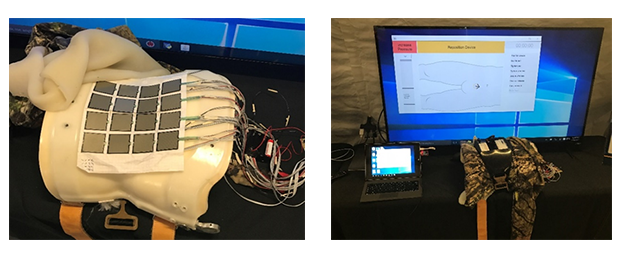The Situation
Battlefield medical treatment has advanced tremendously in recent years; this is exemplified by the development of Tactical Combat Casualty Care (TCCC), which emphasizes immediate attention to life-threatening conditions, such as airway blockage or fatal bleeding. Unfortunately, certain injuries, such as non-compressible hemorrhages in junctional or inguinal areas like the abdomen or pelvis, cannot be addressed by these techniques. Inventors have developed new types of tourniquets to respond to this challenge, which address abdominal and pelvic injuries. While these hemorrhage-control technologies have been validated and approved for use by the FDA as well as accepted into the TCCC guidelines, training systems for these technologies have not been fully realized. Training systems that can teach and refresh skills for these types of injuries are vital because the injuries are rare on the battlefield and difficult to train.
The Charles River Analytics Solution
 Charles River Analytics is developing the Tourniquet Master Training (TMT) system to teach, assess, and provide refresher training on this new tourniquet technology. TMT is a scenario-based training system that allows trainees to practice using tourniquets such as the Sam Junctional Tourniquet (SJT) or the Abdominal Aortic Junctional Tourniquet™ (AAJT) (see photo). TMT includes a sensor-system linked to a software-based virtual mentor that provides automatic, objective assessment and feedback during training. A mobile application provides refresher training during deployment or when a manikin is not available for practice. TMT works with multiple types of manikins and adapts to future tourniquet technology advances.
Charles River Analytics is developing the Tourniquet Master Training (TMT) system to teach, assess, and provide refresher training on this new tourniquet technology. TMT is a scenario-based training system that allows trainees to practice using tourniquets such as the Sam Junctional Tourniquet (SJT) or the Abdominal Aortic Junctional Tourniquet™ (AAJT) (see photo). TMT includes a sensor-system linked to a software-based virtual mentor that provides automatic, objective assessment and feedback during training. A mobile application provides refresher training during deployment or when a manikin is not available for practice. TMT works with multiple types of manikins and adapts to future tourniquet technology advances.
The Abdominal Aortic Junctional Tourniquet™ (Photo courtesy of Compression Works)
The Benefit
TMT addresses a critical need in lifesaving training—since these types of injuries are rare, there are few opportunities to practice treating them. TMT addresses these gaps by providing a training system that enables full pressure applications without the need for live tissue, and is compatible with a variety of low-cost manikins. Tactical emergency medical support providers can also benefit from TMT as the use of advanced tourniquets spreads to non-military organizations, such as the FBI, SWAT teams, and the Department of Homeland Security.
TMT compliments other techniques and mobile applications Charles River has developed to support Warfighters and predict traumatic injury, such as the EPIC3 decision aid to help medics triage casualties and the STAT screen-based simulation to train initial trauma management skills. Other efforts in healthcare support and training include surgical training systems, a first-aid training framework, artificial intelligence-enabled online communities to support recovering amputees, therapeutic applications, decision aids, healthcare data analytics, sensors and sensing technology, and mobile training technology.
See other examples of our Healthcare Support and Training efforts.


Charles River Analytics demonstrating the TMT system at the TATRC open house
This material is based upon work supported by the United States Army Medical Research and Materiel Command under Contract No. W81XWH-13-C-0021. Any opinions, findings and conclusions or recommendations expressed in this material are those of the author(s) and do not necessarily reflect the views of the United States Army Medical Research and Materiel Command.
